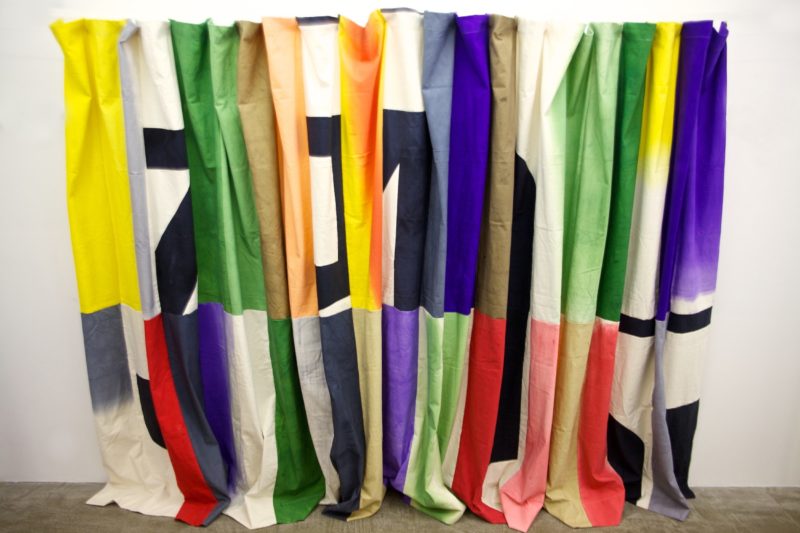
Under the thread
The Art of Fabric in the Collections of Daniel Cordier and les Abattoirs
This exhibition is exclusively devoted to fabric in all its many forms: woven, stitched, stretched, cut, torn, reinterpreted, embroidered, painted, shaped, and worn. Many works have been selected from the Daniel Cordier collection, which was gifted to the Musée national d’Art moderne – Centre Georges Pompidou and later transferred to Les Abattoirs. Creations from across the continents are displayed alongside works by contemporary artists.
For the first time at Les Abattoirs, an exhibition is being exclusively devoted to fabric in all its many forms: woven, stitched, stretched, cut, torn, reinterpreted, embroidered, painted, shaped, designed, and worn. It brings together some twenty historical fabrics created by unknown artists from around the world with works by contemporary artists exploring the materials and strategies used in handicrafts as well as the clothing industry. Some of these artists have reinterpreted techniques issuing from the long history of textiles, such as embroidery or sewing, in order to experiment with new forms. By drawing on what is referred to as “female knowledge” – domestic handicrafts from sometimes poor milieus – these artworks are often characterised by their social commitment, leaving behind classical fine arts conventions, freeing themselves from social mores, and asserting themselves by giving prominence to identities of all genders (female, queer, etc.), ages, and places.
Fabric can be adopted for many different purposes, from the purely functional to the decorative. As wall tapestry, it both insulates and provides decoration for cold spaces. As clothing, it marries the useful with adornment, but can also be a subject for debate: part of a globalised industry since the 19th century, it has been been marked by controversy regarding exploitation and the environment, as well as attribution and emancipation. In the exhibition, several artists focus on the long-standing dispute over the freedom of women’s bodies. Others are interested in the tracksuit, an item of clothing originally designed for exercise that became a symbol of street culture and then of young people in general, representing both an affirmation of freedom and uniformatisation.
In addition to forty or so works from the collection at Les Abattoirs, including some recent acquisitions, this exhibition affords an exceptional look at some rare, sometimes extremely fragile pieces, thanks to the incredible collection assembled by Daniel Cordier. This project is dedicated to the occasion of his 100th birthday. His collection was gifted to the Musée national d’Art moderne – Centre Georges Pompidou and transferred to Les Abattoirs upon its opening.
This artistic journey is completed by a monumental hanging of walls of fabric in which pieces from the entire globe are interwoven, from the 19th century to today’s contemporary world. The use and presentation of humble and marginalised artistic means of production, such as Japanese boro made at a time of great agrarian poverty, call into question the art world’s usual hierarchy, writing a narrative that celebrates creators in the full diversity of their backgrounds, their continents, and their knowledge.
Several artists and institutions with fabric-related collections, in particular in Toulouse and the Occitanie region, have also been invited to contribute so that this hanging will continue to evolve over the coming months. The retrospective devoted to Marion Baruch is also part of this season of fabric art.
With works by: Babi Badalov, Rina Banerjee, Bernard Bazile, Mathieu Boisadan, Hélène Boutonnet, Mohamed Bourouissa, Guillaume Bresson, Alberto Burri, Pia Camil, Pauline Curnier Jardin, Sabine Deshais, Tracey Emin, Esther Ferrer, Anna Franceschini, Loïe Fuller, Hessie, General Idea, Isabelle Jarousse, Horst Egon Kalinowski, Lawrence Lemaoana, Les frères Lumières, Juana Polo, Mamaii, Robert Mapplethorpe, Senzeni Marasela, Teresa Margolles, Fatima Mazmouz, Myriam Mihindou, Manolo Millares, Robert Morris, Zanele Muholi, Présence Panchounette, François Rouan, Patrick Saytour, Annegret Soltau, Nicolas Simarik, Michael E. Smith, Clément Thomas, Béatrice Utrilla, Claude Viallat, Gisèle Vienne, Lawrence Weiner and unknown artists from Japan, Mali, Uzbekistan, Peru, and the Democratic Republic of Congo.
